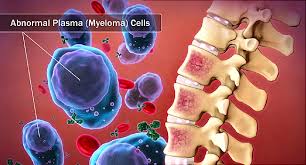Postoperative spinal radiotherapy for myeloma patients is both safe and effective according to the article linked below. However, I have to mention some cautions.
I underwent surgical removal of myeloma for my first therapy followed by local radiotherapy. It’s important for me to point out that the dose mentioned in the study was much less than the dose I was given.
Myeloma involvement in a patient’s spine is common. The challenge is to figure out what can go right with radiation and what can go wrong.
What are the pros and cons of post surgical radiation for multiple myeloma?
Pros:
- Targeted Treatment: Radiation therapy can be precisely targeted to specific areas of the body affected by myeloma, potentially reducing damage to surrounding healthy tissues.
- Local Control: It can help to control or eradicate cancer cells in the treated area, reducing the risk of recurrence or progression at that specific site.
- Symptom Relief: Radiation therapy can alleviate symptoms such as pain or discomfort caused by tumors pressing on nerves or other structures.
- Adjunct to Surgery: In cases where surgery is performed to remove a tumor or alleviate complications, radiation therapy can be used to further reduce the risk of local recurrence.
- Potential for Improved Survival: Depending on the individual case and extent of disease, post-surgical radiation therapy may contribute to improved overall survival rates.
Cons:
- Side Effects: Radiation therapy can cause side effects such as fatigue, skin irritation, hair loss (in the treated area), and damage to nearby organs or tissues.
- Risk of Secondary Cancers: There is a small risk of developing secondary cancers in the area that has been treated with radiation, although this risk is typically outweighed by the benefits of treatment.
- Delayed Healing: Radiation therapy can slow down the healing process in the treated area, particularly if surgery has been performed concurrently.
- Limited Effectiveness for Widespread Disease: Radiation therapy is most effective when targeting localized areas of disease. It may not be as beneficial for widespread or diffuse involvement of multiple myeloma.
- Logistical Challenges: Radiation therapy requires multiple sessions over several weeks, which can be logistically challenging for some patients, especially if they live far from treatment centers or have mobility issues.
The key issue mentioned in the study below, in my experience anyway, is the radiation dose. I say this because radiation to the spine is potentially dangerous and can cause a host of serious long-term side effects. Because I underwent two different postoperative spinal radiotherapy sessions the total dose to my spine was much higher and my long-term side effects were much more serious.
The reason why a low dose of radiation can be used for postoperative spinal radiotherapy for myeloma patients is highlighted in the second study below. MM is sensitive to radiation.
Lastly, if you take precautions before, during and after postoperative spinal radiotherapy, you will reduce your risks even more.

man hand holding his nutritional supplemets, healthy lifestyle background.
Consider-
The bottom line for myeloma patients is, like all conventional therapies radiation is a double-edged sword. And in my experience, oncology leans towards aggressive treatment at the expense of long-term side effects. Long-term meaning that my side effects took hold years after my chemo and radiation. Years…
So it is the patient who often bears the responsibility of what therapy, how much, etc. The information in this post is designed to temper the information in the study linked below.
Are you a newly diagnosed myeloma patient? What stage? What are your symptoms? Any bone pain in your spine? Let me know- David.PeopleBeatingCancer@gmail.com
Thanks,
David Emerson
MM Survivor
MM Cancer Coach
Director PeopleBeatingCancer
“In a retrospective study, a majority of patients with multiple reported reduced pain after radiotherapy following spinal surgery for osteolytic lesions…
“[In patients with osteolytic bone lesions of MM], a radiation dose of 30Gy delivered in 10-15 fractions is one of the most common RT regimens in this situation and is able to achieve significant reduction of pain in most patients…”
Researchers conducted a single-center, retrospective study of the outcomes of patients who underwent spinal surgery and postoperative RT due to MM. The primary endpoint was overall survival (OS), and secondary endpoints were progression-free survival (PFS), pain response, local control, and skeletal-related events…
After surgery, the 3‑ and 5‑year OS was 74.9% and 58%, respectively. Median survival was not reached. Median PFS was 26.5 months (95% CI, 20.9-48.4 months)…
Grade 1/2 adverse events (AEs) occurred in 24% of patients, and no grade 3/4 AEs occurred. Skeletal-related events occurred in 2 patients (4%)…
To our knowledge, this is the first study to demonstrate both the safety and efficacy of RT in MM patients in an exclusively postsurgical setting of spinal lesions,” the authors wrote in their report. “The low rate of [skeletal-related events] and the absence of in-field recurrences demonstrate the efficacy of RT in MM patients…
“To our knowledge, this is the first study to demonstrate both the safety and efficacy of RT in MM patients in an exclusively postsurgical setting of spinal lesions,” the authors wrote in their report. “The low rate of [skeletal-related events] and the absence of in-field recurrences demonstrate the efficacy of RT in MM patients. The Bilsky score is an easy-to-calculate prognostic tool and should be considered before dose prescription, given its prognostic value in MM patients receiving postoperative RT after spinal surgery.””
“…Myeloma is very sensitive to radiotherapy, which is usually given to specific bones when the myeloma cells have created a weak area causing pain and sometimes a risk of bones breaking. This treatment can be effective at relieving the pain and allowing the bones to repair themselves. Only one or two treatments may be required, and pain should improve within 2-3 weeks…”




